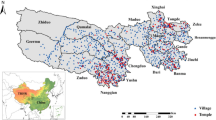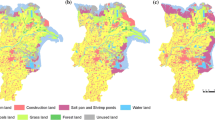Abstract
Yangshao culture is the most important mid-Holocene Neolithic culture in the Yellow River catchment, and thus, a study on the impact of human activities on the environment is important. In the current study, the distribution pattern of the cultivated land in late Yangshao culture is reconstructed using GIS tool and site domain analysis (SDA). The results show that the cultivated land during 5.5–5.0 ka BP was mainly distributed in the Weihe River valley, Luohe River valley, northwestern Henan Plain, Fenhe River valley and eastern Gansu region, especially concentrated in the Xi’an-Baoji line of the Weihe River valley. At that time, at least 37,000 km2 of lands were reclaimed in the middle and lower reaches of the Yellow River, and 132,000 km2 of lands were affected by agricultural activities. Human activities had become the driving force of land use/land coverage. Charcoal records indicate that the ancestors of Yangshao culture burnt forests for reclamation, leading to the decrease of arbor pollen at 5 ka BP in core areas of the Yangshao culture. The areas that were significantly affected by human activities accounted for 3.2% of the Yangshao culture influenced area, while the moderately affected areas accounted for 20.1% of Yangshao culture influenced area. Meanwhile, 92% of the land areas on the edge and outside of the Yangshao culture influenced area were not affected by human activities. The arbor pollen in these areas did not decrease until 4.0 ka BP.
Similar content being viewed by others
References
An Chengbang, Feng Zhaodong, Tang Lingyu, 2003. The evidence of humid climate in western Loess Plateau in the middle Holocene. Chinese Science Bulletin, 48(21): 2280–2287. (in Chinese)
Cao Yanfeng, Huang Chunchang, Han Junqing et al., 2007. Changes of fire environment recorded by charcoal hided in Holocene profiles in the eastern and western Loess Plateau. Geography and Geo-information Science, 23(1): 92–96. (in Chinese)
Caseldine C, Hatton J, 1993. The development of high moorland on Dartmoor: Fire and the influence of Mesolithic activity on vegetation change. In: Chambers F M (ed.). Climatic Change and Human Impact on the Landscape. UK: Chapman & Hall Press, 109–118.
Cheng Bo, Chen Fuahu, Zhang Jiawu, 2010. Palaeovegetational and palaeoenvironmental changes in Gonghe Basin since last deglaciation. Acta Geographica Sinica, 65(11): 1336–1344. (in Chinese)
Edwards K J, MacDonald G M, 1991. Holocene palynology: Human influence and vegetation change. Progress in Physical Geography, 15(4): 364–391.
Fang Xiuqi, Zhang Wenbo, Zhang Lansheng, 1998. The land use arrangement of China in the Holocene Megathermal period and its significance. Journal of Natural Resources, 13(1): 16–22. (in Chinese)
FAO, 1976. A framework for land evaluation. FAO Soils Bulletin 32. http://www.fao.org/docrep/X5310E/X5310E00.htm.
Haberle S G, Hope G S, Kaars V D, 2001. Biomass burning in Indonesia and Papua New Guinea: Natural and human induced fire events in the fossil record. Palaeogeography, Palaeoclimatology, Palaeoecology, 171(3): 259–268.
Herzschuh U, Birks H J B, Liu Xingqi et al., 2009. What caused the mid-Holocene forest decline on the eastern Tibet-Qinghai Plateau? Global Ecology and Biogeography, 51(4): 1–9.
Higgs E S, Vita-Finzi C, 1972. Prehistoric economies: A territorial approach. In: Higgs E S (eds). Papers in Economic Prehistory. Cambridge: Cambridge University Press, 27–36.
Jin Guiyun, Liu Dongsheng, 2001. Cool climate events and the ancient cultural change in middle Holocene in North China. Chinese Science Bulletin, 46(20): 1725–1729. (in Chinese)
Li Bingcheng, 2004. Discussion on Holocene palaeoclimate environment in the ruins Banpo in Xi`an. Journal of Northwest University (Natural Science Edition), 34(4): 485–488. (in Chinese)
Li Bingcheng, 2006. The Holocene climate and environment of Ningxia Shuidonggou site. Jilin University Journal (Earth Science Edition), 36(1): 49–53. (in Chinese)
Li Xiaoqiang, Dodson John, Zhou Xinying et al., 2007. Early cultivated wheat and broadening of agriculture in Neolithic China. Holocene, 17(5): 555–560.
Li Yigen, Zhou Liping, Cui Haiting, 2008. Human activities pollen instructions body. Chinese Science Bulletin, 53(9): 991–1002. (in Chinese)
Liu Hongyan, Cui Haiting, Tian Yuhong et al., 2002. Temporal-spatial variances of Holocene precipitation at the marginal area of the East Asian monsoon influences from pollen evidence. Acta Botanica Sinica, 44(6): 864–871. (in Chinese)
Liu Xingqi, Shen Ji, Wang Sumin et al., 2002. A 16000-year pollen record and ancient environmental evolution. Chinese Science Bulletin, 47(17): 1351–1355. (in Chinese)
Lowe J J, Walker M J C, 1997. Reconstructing Quaternary Environments. 2nd ed. UK: Addison Wesley Longman Limited.
Lüthi D, Floch M L, Bereiter B et al., 2008. High-resolution carbon dioxide concentration record 650,000–800,000 years before present. Nature, 453: 379–382.
Meng Xiangang, Zhu Dagang, Shao Zhaogang et al., 2007 Paleoclimatic and plaeoenvironmental evolution since Holocene in the Ningwu area, Shanxi province. Acta Geologica Sinica, 81(3): 316–323. (in Chinese)
National Soil Survey Office, 1998. Chinese Soil. Beijing: China Agricultural Press, 156–188. (in Chinese)
PAGES, 2009. PAGES (2009) science plan and implementation strategy. IGBP Report No.57. IGBP Secretariat, Stockholm, 1–67.
Prentice I C, Webb T, 1998. BIOME 6000: Reconstructing global mid-Holocene vegetation patterns from palaeoecological records. Journal of Biogeography, 25(4): 997–1005.
Qiao Yu, 2010. Development of complex societies in the Yiluo region: A GIS based population and agricultural area analysis. Acta Archaeologica Sinica, 45(4): 423–454. (in Chinese)
Qin Ling, Fuller D Q, Zhang Hai, 2010. Modeling wild food resource catchments amongst early farmers: Case studies from the lower Yangtze and central China. Quaternary Sciences, 30(2): 245–260. (in Chinese)
Ren Guoyu, 2000. Decline of the mid- to late Holocene forests in China: Climatic change or human impact? Journal of Quaternary Science, 15(3): 273–281.
Ren Shinan, 2005. The occurrence and development of the pre-historical agriculture in China. Academic Research, 25(6): 110–123. (in Chinese)
Shelach G, 1999. Leadership Strategies, Economic Activity, and Interregional Interaction: Social Complexity in Northeast China, New York: Kluwer Academic, Plenum Press, 121–138.
State Administration of Cultural Heritage, 1991. The Culture Relic Atlas of China: Henan Branch. Beijing: China Cartographic Publishing House, 13–20. (in Chinese)
State Administration of Cultural Heritage, 1996. The Culture Relic Atlas of China: Qinghai Branch. Beijing: China Cartographic Publishing House, 15–23. (in Chinese)
State Administration of Cultural Heritage, 1998. The Culture Relic Atlas of China: Shaanxi Branch. Xi’an: Xi’an Cartographic Publishing House, 17–28. (in Chinese)
State Administration of Cultural Heritage, 2003. The Culture Relic Atlas of China: Inner Mongolia Branch. Xi’an: Xi’an Cartographic Publishing House, 19–26. (in Chinese)
State Administration of Cultural Heritage, 2007. The Culture Relic Atlas of China: Shanxi Branch. Beijing: China Cartographic Publishing House, 16–26. (in Chinese)
Tan Zhihai, Huang Chunchang, Pang Jiangli et al., 2008. Charcoal recorded Holocene fire history in the northern part of the Longdong Loess Plateau. Quaternary Sciences, 28(4): 733–738. (in Chinese)
Tang Lingyu, Li Chunhai, An Chengbang et al., 2007. Vegetation history of the western Loess Plateau of China during the last 40ka based on pollen record. Acta Palaeontologica Sinica, 46(1): 45–61. (in Chinese)
Tang Lingyu, Shen Caiming, Zhao Xitao, 1993. 10 thousand years’ vegetation and climate indicated in section of Qingfeng, Jian River, Jiangsu Province. Science in China (B Series), 23(6): 637–643. (in Chinese)
Tong Guobang, Wu Ruijin, Wu Yanhong et al., 2000. Vegetation and environment variations since Holocene in Mianning area, Sichuan Province. Acta Micropalaeontologica Sinica, 17(4): 470–477. (in Chinese)
Vita-Finzi C, Higgs E S, 1970. Prehistoric economy in the Mount Carmel area of Palestine: Site catchment analysis. Proceedings of the Prehistoric Society, 36(3): 1–37.
Wang Fubao, Han Huiyou, Yan Ge et al., 1996. The ancient vegetation and climate evolution sequence in northeastern Tibetan Plateau since 30ka. Science in China (D Series), 26(2): 111–117. (in Chinese)
Wang Pengyu, Sun Xiangjun, 1997. The preliminary study of environment change in Holocene indicated in peat profile in Chayansuqi, Inner Mongolia. Chinese Science Bulletin, 42(5): 514–518. (in Chinese)
Xiao Jule, Xu Qinghai, Toshio Nakamura et al., 2004. Holocene vegetation variation in the Daihai Lake region of north-central China: A direct indication of the Asian monsoon climatic history. Quaternary Science Reviews, 23(2): 1669–1679.
Xu Qinghai, Chen Shuyin, Kong Zhaochen et al., 1988. Preliminary discussion of vegetation succession and climate change during the Holocene in Baiyangdian Lake District. Acta Phytoecologica et Geobotanica Sinica, 12(6): 144–151. (in Chinese)
Xu Qinghai, Yang Xiaolan, Yang Zhenjing et al., 2004. Reconstruction of climatic changes of Yanshan Mountain area since 5000 a B. P. inferred from pollen data. Scientia Geographica Sinica, 24(3): 339–344. (in Chinese)
Yan Wenming, 2000. Appearance of Agriculture and Origin of Culture. Beijing: Science Press, 1–20. (in Chinese)
Yang Xiangdong, Zhu Yuxin, Jiang Xuezhong et al., 1998. Environmental Changes from spore-pollen record of Mianyang region over the past 10000 years. Journal of Lake Sciences, 10(2): 23–28. (in Chinese)
Yang Zhirong, 1998. The preliminary study on the climate and environment during the megathermal of the Holocene in middle-west Inner Mongolia. Scientia Geographica Sinica, 18(5): 479–485. (in Chinese)
Yu Yanyan, Wu Haibin, Guo Zhentang, 2010. A new simulation model for prehistoric land use and carbon storage (PLCM): An application in Yiluo valleys. Quaternary Sciences, 30(2): 540–549. (in Chinese)
Zhang Zhenqing, Xu Qinghai, Li Yuecong et al., 2007. Environmental changes of the Yin ruins area based on pollen analysis. Quaternary Sciences, 27(3): 461–468. (in Chinese)
Zhou Aifeng, Sun Huilin, Chen Fahu et al., 2010. High-resolution climate change in mid-late Holocene on Tianchi Lake, Liupan Mountain in the Loess Plateau in central China and its significance. Chinese Science Bulletin, 55, doi: 10.1007/s11434-010-3226-0. (in Chinese)
Zhou Xinying, Li Xiaoqiang, Zhao Keliang et al., 2011. Early agricultural development and environment effects in the Neoloithic Longdong basin (East Gansu). Chinese Science Bulletin, 56(4/5): 318–326. (in Chinese)
Zhu Cheng, Ma Chunmei, Zhang Wenqing et al., 2006. Pollen record from Dajiuhu Basin of Shennongjia and environmental changes since 15.753 kaBP. Quaternary Sciences, 26(5): 814–826. (in Chinese)
Author information
Authors and Affiliations
Corresponding author
Additional information
Foundation: National Natural Science Foundation of China, No.41161018; No.41121001; China Geological Survey, No.1212011120046; Humanities and Social Sciences Youth Fund Project of Ministry of Education of China, No.10YJCZH041; and The “Strategic Priority Research Program” of the CAS, No.XDA05120501.
Author: Hou Guangliang (1972–), Ph.D and Associate Professor, specialized in environmental changes and human activity.
Rights and permissions
About this article
Cite this article
Hou, G., Lai, Z., Xiao, J. et al. Reconstruction of cultivated land during mid- Holocene in the middle and lower reaches of Yellow River and human impact on vegetations. J. Geogr. Sci. 22, 933–945 (2012). https://doi.org/10.1007/s11442-012-0974-6
Received:
Accepted:
Published:
Issue Date:
DOI: https://doi.org/10.1007/s11442-012-0974-6




